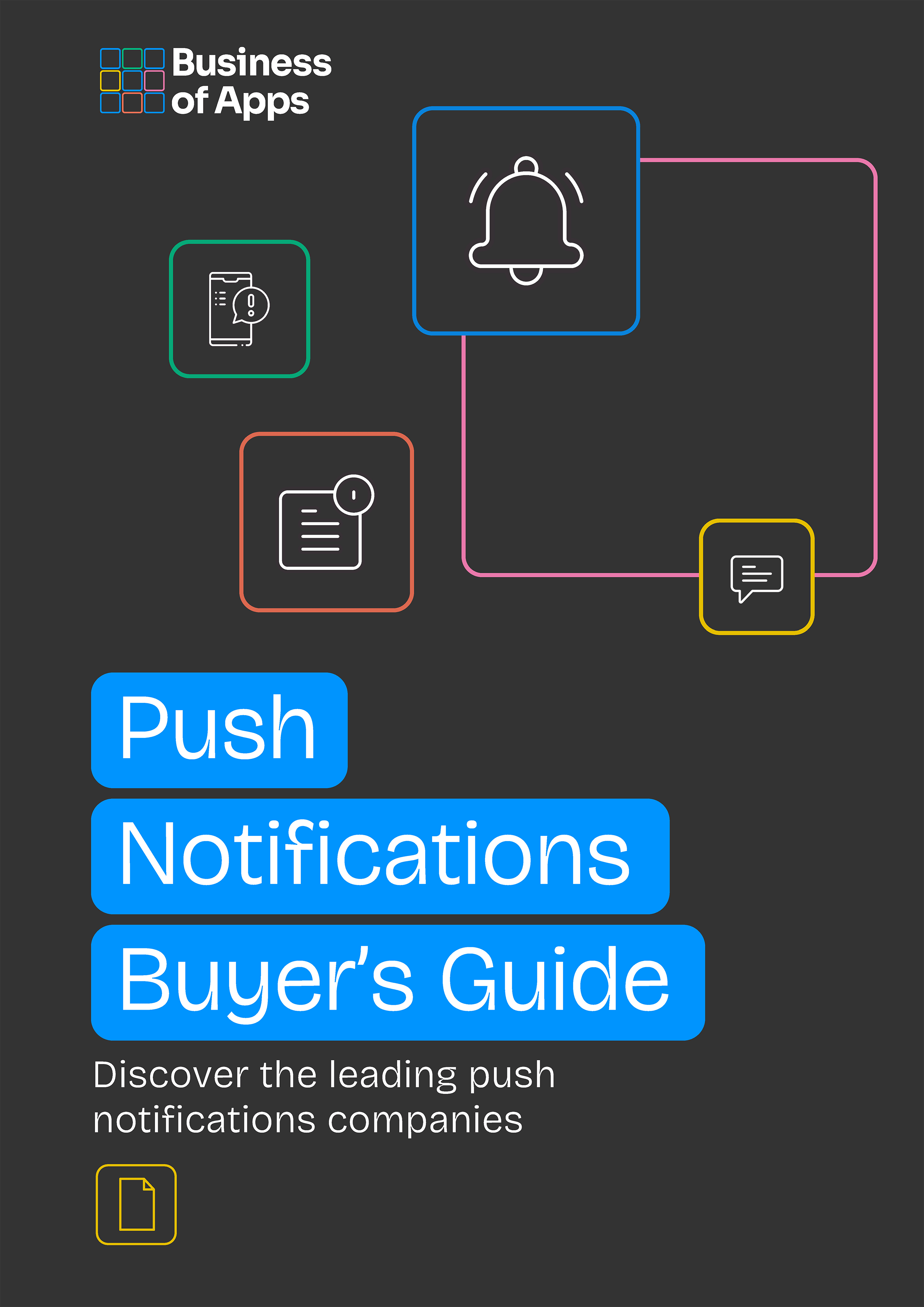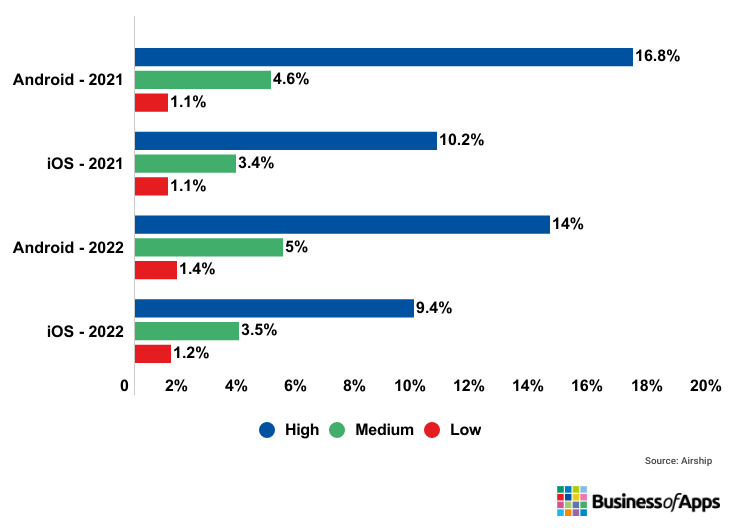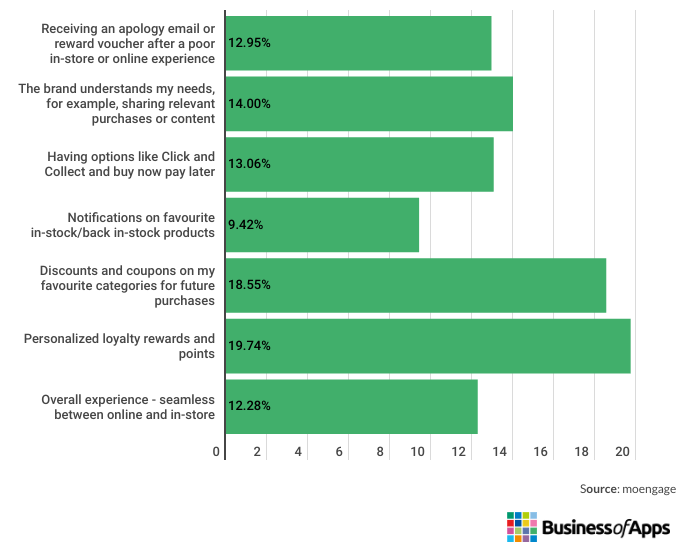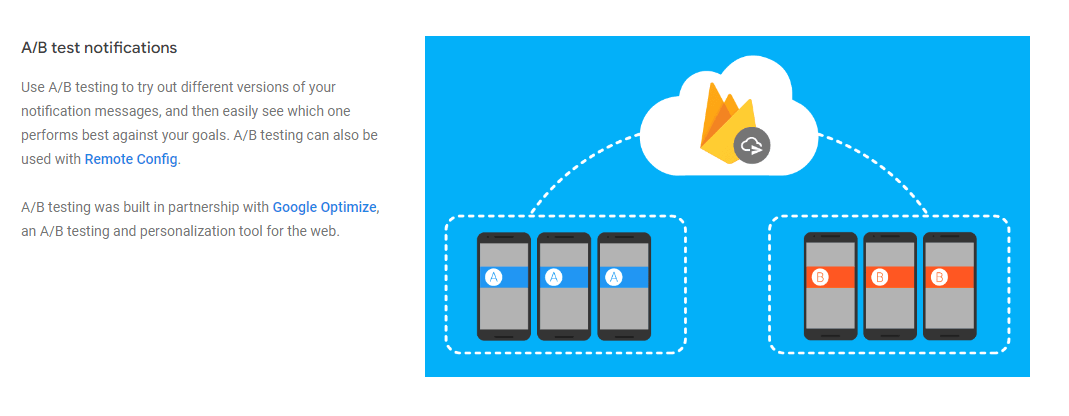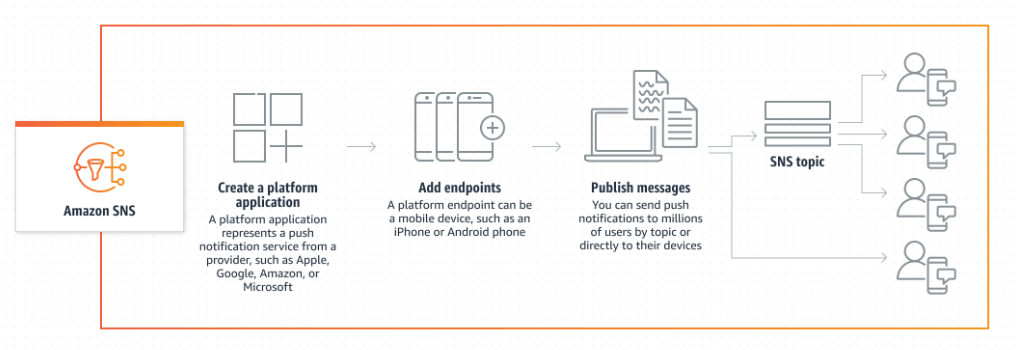Estimating a push notification cost isn’t easy and depends on a range of variables. But because push notifications can result in dramatic alterations to engagement, ROI, and long-term app growth, it’s worth doing. By targeting users’ smartphone lock screens, push notifications can drive higher Click-Through-Rates (CTRs). So, anyone who’s trying to determine the cost of mobile app advertising should also make sure to include a budget for push notifications. Most often, the best push strategies start with finding an appropriate pricing model, strong creatives, and the right communication frequency.
Featured Push Notifications Services
To help with drawing up a push notification cost strategy, this paper outlines appropriate price rates, average costs, and a list of influential variables. Making reference to research and statistics, this paper offers access to cost-efficient pricing models that should make it easier to integrate push notifications into your strategy. And to approach push notifications services for support. As a notable strategy to reduce churn and bounce rates, personalization can lead to better retention. So, this paper will explore research on a potential push notification cost along with a variety of factors that can influence them.
Streamline your push notification campaigns
One engine for highly personalized, segmented messages, and analytics
Learn moreKey data points
- Push opt-in rates on Android reached an average of 93.5% in 2022 for the top 90th percentile (Airship)
- Average push opt-in rates on iOS in 2022 were 76.4% for the top 90th percentile (Airship)
- Direct open rates in the top range decreased between 2021 and 2022 but low and medium ranges saw a slight increase via better segmentation and personalization.
- Average CPM rates for a push notification cost start at $0.01 (PropellerAds)
- Minimum CPC rates in the United States can run anywhere between $0.003 to $0.159 according to RichAdsNetwork.
- CTR is almost 50% higher for push ads and notifications with images. Larger visual icons can gain CTR rates of 42.5% with smaller icons achieving 21.6%.
- Brands can increase their 90-day app retention by as much as 190% when they introduce push notifications (Airship)
- The probability of users uninstalling an app increases in line with the frequency of notifications.
- Uninstall rates climbed in 2021 to an average cost of $57k
- 78% of users churn in the first week after installation when brands don’t have a clear engagement strategy based on regular push notifications (Airship)
- 10% of users disable app push notifications when they receive one notification per week.
- Users who disable push ads can rise to 40% when they get 3-6 notifications per week.
- Basic personalization can increase open rates by 9%. (CleverTap)
- Adding Emojis has the potential to increase CTRs by 9.6%.
What are mobile push notifications?
App push notifications are short messages sent to app users’ smartphone screens. App users can receive them at any time without having the app open. And so long as they judge an appropriate frequency, app publishers can get a captive, targettable audience to sell to.
Examples of push notifications include news updates, calendar reminders, location confirmations, and Direct Messages. Push ads may feature promotions, affiliate deals, surveys, and competitions. Each type of push format serves the purpose of encouraging user actions while striving to keep app users engaged.
Push Notifications Buyer's Guide
Download our Push Notifications Buyer’s Guide to get a full list of the best service providers on the market to choose from. Also, learn what push notifications are, how to choose a provider, and about main categories of push notifications providers.
Finding the right balance is important for a low push notification cost
The most effective way to drive value from the cost of a push notification is by locating the sweet spot between too many and too few. When users feel they’re getting too many pushes at the wrong time, it can make them uninstall the app. But it’s also possible they will lose interest when you don’t engage with them enough.
In their paper “Mobile apps in retail: Effect of push notification frequency on app user behavior”, authors Wohllebe. A, Hübner. DS, R. Uwe, and Podruzsik, S. (2021) explore where the perfect balance may lie using four hypotheses:
- With increasing frequency of push notifications, the probability of an app uninstall increases.
- With increasing frequency of push notifications, the probability of a direct open decreases.
- With increasing frequency of push notifications, the probability of an indirect open decreases.
- The negative effect of frequency on direct opens is stronger than the effect on indirect opens.
Using 17,500 app users to experiment on, researchers found the probability of an uninstall increased in line with the frequency of push notifications. And, along with a well-planned frequency, authors recommend ensuring all content remains relevant and adds value. They also suggest how too many push notifications will come at a cost to developers and recommend reviewing uninstall rates against notification frequency. Doing so can help to calculate the total push notification cost.
Our own stats back up this premise suggesting 10% of users disable app push notifications when they receive one per week. This can even rise to as high as 40% if they feel they get too many. Something that can equate to around 3-6 notifications per week.
Advantages of push notifications
Advertisers and publishers can gain many advantages from a low push notification cost. Some ways to keep costs low include the following:
Lower churn
Research from Airship finds 78% of users churn in the first-week post-install when brands don’t have a clear engagement strategy. Further research by Wohllebe. A, Hübner. DS, R. Uwe, and Podruzsik, S. (2021) suggest that uninstall rates should be the principal metric for calculating a push notification cost. In practice, the higher the uninstall rate the higher the cost of investment. But there are several ways that finding the right push notification cost can help to improve churn rates:
- Sending reminders: eCommerce users can send anniversary, birthday, or holiday gifts, and push notifications can act as helpful reminders to log in to the app and select a gift.
- Engaging new customers: Sending appropriate personalized reminders to users when they install an app can keep them engaged and prevent them from losing interest.
- Boosting customer service levels: Sending push notifications can improve customer service levels by advertising new deals or promotions. They’re also helpful in keeping customers informed of any disruptions to service.
Reduced bounce rate
If you’re losing users, push notifications are a good way to bring them back. Several studies suggest that returning customers can spend 67% more than new ones, which makes reducing your bounce rate important for revenue generation. Bounce rate is usually measured by the percentage of users who leave an app after viewing it once. And you can reduce your bounce rate by sending well-crafted push messages at the right time.
Inactive user behavior
Inactive or dormant users may not have logged into an app for some time. There is no set time frame to define inactive users. Some suggest 30 days or more without opening an app suggests it’s unlikely a user will return without a prompt. Statistics from Airship indicate that brands can increase their 90-day app retention by as much as 190% with push notifications. And this is why it’s important to find the correct balance between sending too many and not enough.
Push notification costs come in different forms
In this section, we’ll review the different pricing models and the factors that influence them. Selecting the most appropriate pricing model is one of the best ways to leverage a push notification cost. Doing so can lead to higher CTRs and better conversions. And, when joined up with the right creative prompts, the right model can promote long-term engagement and improved ROI.
Our research shows how push notification ads can gain CTRs at 4.6% on Android, with iOS averaging 3.4%. Plus, a study by CleverTap found basic personalization can increase open rates by 9%. Adding Emojis also has the potential to increase CTRs by 9.6%. So, with high CTRs being the ultimate aim to drive conversions, marketers should give careful consideration to the most appropriate pricing model. Rates will vary based on several factors, including variances between countries or territories. CPM and CPC are models most often used to determine a push notification cost, with options for CPA and CPI/CPE too:
CPM (Cost-Per-Mile)
This is a fixed-rate model that allows marketers to only pay for the number of times an ad shows up. This is sometimes referred to as Cost-Per-Impression, or Cost-Per-Thousand since you pay for every 1,000 ads published. CPM is a fixed rate, which offers a predictable and measurable means of driving CTRs. Average CPM rates for a push notification cost start at $0.01, according to PropellerAds. And when we compare this to the standard CPM for a Facebook Ad which is $12.4, a push notification cost offers an attractive alternative.
Using the CPM model rate allows marketers to generate revenue from both the bid and the CTR using the following equation:
No. of visitors = (Total Cost/CPM Bid x 1,000) x CTR
Cost Per Visitor for CPM model = Total Cost / Amount of Visitors you need
With a push notification CTR at 2% and a CPM bid at $0.01, you could expect to pay $10 for 20,000 impressions.
$10 / $0.01 x 1,000 x 2% = 20,000
$10 / 20,000 = $0.0005
Cost of one visitor = $0.0005
CPC (Cost-Per-Click)
CPC rates offer an alternative to spending any campaign budget only on impressions that actually lead to clicks. And since you only pay for clicks, ads go out to relevant audiences at no cost. According to RichAdsNetwork, minimum CPCs in the United States can run anywhere between $0.003 to $0.159.
Push traffic is often purchased using the CPC model which means there’s less chance of paying for an audience you don’t want to attract. They can drive conversions at a low CPA rate. Plus they offer a less expensive marketing channel over Facebook or other in-app marketing efforts. They are much less expensive than Facebook or other in-app marketing channels. Despite the lack of interest-based targeting, it’s a great way to drive conversions at a low CPA to popular verticals. Furthermore, since push traffic is often purchased using the CPC (cost-per-click) model, you won’t overpay for an irrelevant audience. This benefit makes push advertising a smart choice for both direct advertisers and affiliate marketers looking to scale ad campaigns.
So, if you’re working with the CPC model the bid will affect how much you pay per visitor.
No. of Visitors = Total Cost / CPC Bid
Cost Per Visitor for CPC model = CPC Bid
With a minimum CPC bid of $0.003, you receive 2,000 visitors.
$10 / $ 0.005 = 3,333
The cost of one visitor is $0.005
Examples of Push Ad CPC Rates
| Country Name | Push Ad CPC Rates |
|---|---|
| USA | $0.20 |
| India | $0.01 |
| United Kingdom | $0.05 |
| Australia | $0.15 |
| Canada | $0.22 |
| South Africa | $0.04 |
| Japan | $0.05 |
| Indonesia | $0.02 |
| Philippines | $0.02 |
| Pakistan | $0.01 |
Source: AdCPMRates.com
CPA
Marketers can use cost-per-action rates (CPA) for push notifications that focus on promoting actions outside of the app. Examples may be building an email list, signing up for a promotion, or social media shares. And it’s one approach that’s useful when working with affiliates such as influencers. The average CPA rate in 2020 for purchase and subscription was $40.
“There are a lot of companies right now, with this harsh economy, going towards CPA type of payment to the influencers. So they are paying based on actions that they want influencers to perform.”
Lucia Aguir, Founder, Tatum.Digital
CPA rates will vary by industry, territory, and platform used. And, in a recent Business of Apps podcast, the founder of Tatum.Digital Lucia Aguilar suggests that inflation will impact rates in 2023. They also predict that 50% of the people who click on a push ad will redeem the code.
CPI
Using CPI to track push notifications performance may have declined in popularity in recent years, but it’s still a useful metric to track. And it’s a rate pricing model that may hold sway if you’re looking to run push notifications to promote new apps. For instance, it may be useful to apply to downloads of the next installment in a gaming series or a new version of an app.
The average mobile app CPI across a range of territories includes:
- APAC – $0.93
- EMEA – $1.03
- Latin America – $1.03
- North America – $5.28
Measuring push notification costs using ROI
Along with selecting the right pricing model, calculating a push notification cost centers on maximizing ROI. According to MoEngage, push notifications have the ability to deliver ROIs as high as 3500%. And there are several key metrics that help to influence strong ROI and keep a push notification cost down.
- Open rate: Airship’s 2023 benchmark report reveals how segmentation and personalization are the keys to driving efficient use of push notifications and result in higher push notification open rates.
- Opt-in rate: The rate of users opting in to receive push notifications is usually higher on Android over iOS. But since Android 12 and Android 13 are the first to need permission to opt-in, we may see rates decline over time.
- Opt-out rate: Tracking subscriber attrition helps with determining the best volume of push notifications to send.
- Delivery rate: Delivery rate can help to calculate the ratio of impressions and delivered messages sent to subscribers.
- View rate: Lets you understand the number of people viewing your push notifications.
- Conversion rate: According to TapJoy, gaming apps have the highest rates of conversion with adventure games reaching almost 70%, trivia 33.33%, and puzzle or strategy games coming in at under 30%
- Click-through rate: A good CTR suggests you are reaching the right audience with appropriate marketing that’s sent at the right time.
- Uninstall rate: Our own research in 2021 found uninstall rates were climbing, with 2020 seeing a 70% increase in 2019. This comes at an average cost of $57k per month.
- Average order value (Ecommerce): This measures the average total of every order placed over a defined period of time.
- Average Revenue Per User: Tracking your ARPU rate helps to understand which techniques may be most effective.
Push Notification Direct Open Rates – 2021/2022
Source: Airship
Factors that can influence a push notification cost
Some key factors can influence a push notification cost. For example, eMarketer says over 40% of US smartphone users adjust their settings if they feel they’re getting too many push notifications. Plus, increased fears over cybersecurity issues such as spamming and phishing can result in lost trust in brands. Particularly if users feel they don’t respect their privacy.
In light of this, marketers must use strategies that maximize the potential of any push notification efforts. Here are a couple of the most essential ones:
Personalization can reduce a push notification cost
Push notification personalization can improve reaction rates by 400%. And data suggests sending targeted push notifications can enable increased retention of over 40% over 11+ sessions. By helping to address users’ expectations and match their needs, personalized push ads can drive higher revenues. MoEngage reveals evidence for this with data on how personalized push notifications can increase conversions by 4x.
MoEngage also issued a recent report showing how 50% of surveyed Europeans said they enjoyed discounts and rewards personalized to them. And these expectations are what is driving personalization throughout many online and offline shopping experiences. By targeting customers based on their likes, needs, preferences, and specific shopping activity, push notification personalization via push ads can improve targeting and retargeting rates in ecommerce and online sales.
Personalization elements that delight European consumers most
Source: MoEngage
Consumers also perceive personalization as a trade-off since they know that personalization comes at a cost. Research on personalization by Segijn. C.M and Ooijen. I.V, (2020) at the University of Minnesota and Radboud University highlights this in their comparison between the two strategies. Their paper posits how personalized advertising is only effective when a customer perceives that the benefits of engagement will outweigh the costs.
For instance, a consumer may agree to the use of cookies to capture browsing history. In return, they can be safe in the knowledge they will enjoy appropriate and relevant promotions, i.e. things they want and need. The chart below highlights two strands of Online Behavioural Advertising (OBA) and Synced Advertising (SA).
Online Behavioural Advertising versus Synced Advertising
| Personalization Strategy | Online Behavioral Advertising | Synced Advertising |
|---|---|---|
| Definition | "The practice of monitoring people's online behavior and using the collected information to show people individually targeted advertisements" (Boerman, Kruikemeier, & Zuidervein Borgesius 2017, p364 | "The practice of monitoring people's current media behavior and using the collected information to show people individually targeted ads based on people's media behavior across media (Segijn, 2019 p59) |
| Scenario | "Imagine that you like to travel. You visit a website about what's it's like to visit the west coast. The website includes information about Los Angeles. Some time after, you visit another website. One of the ads on the second website is for Continental Airlines, offering a cheap flight to Los Angeles. The ad does not come to you directly for the airline. Instead there is an ad company that determines the ad to show you, personally, based on the first website that you visited about visiting the west coast. If you wouldn't have visited this website, this ad would not have appeared on the second website." Based on McDonald and Cranor, 2010 | "Imagine that you like to travel. You are watching a travel show on television about the west coast. At the same time you are using your smartphone. Someone is interviewed on the travel show and is talking about Los Angeles. At the same time, you receive an ad on your smartphone for flight tickets from Continental Airlines to Los Angeles. That ad on your smartphone does not come directly to you from the airline. Instead, there is an ad company that determines what ad to show you, personally, based on what is said on the show. If you would've watched a different show or no television, this ad would not have appeared on your smartphone." |
Source: “Differences in consumer knowledge and perceptions of personalized advertising: Comparing online behavioral advertising and synced advertising”.
Engagement strategy
Plotting the extent of app user engagement through a user journey can help determine the impact on a push notification cost. For instance, MoEngage suggests that push notification click-through rates are 7x higher than they are for emails and SMS. But they also offer open rates at 50% higher.
If developers want to focus on increasing CTRs even further, studies suggest adding visuals has a marked impact. Researchers R. Avraham Bahir, Y. Parmet, and N. Tractinsky (2022) explored this by reviewing the actions of 6,866 users receiving relevant smartphone notifications. Tracking the influence of visual receptivity, they found CTR was almost 50% higher for notifications with images compared to other designs. But they also note that larger icons can mean higher CTR rates of 42.5%, over smaller icons at 21.6%.
Marketers can also elicit varying response times using a push badge. These are small icons that show up on a push notification, often as numerical counters that represent inbox volumes. A push badge can represent different things and, according to PropellerAds, can increase CTR from 10% to 200%+. Ecommerce marketers usually find they can increase CTRs and conversions using this method, with examples outlined in the chart below.
Rates of impact on CTR using different push badges – PropellerAds
Source: PropellerAds
Push notifications should also be a feature in augmented reality apps, where visual stimulus is of the highest importance. AR and VR headsets are also offering exciting opportunities for visual push notifications with Apple releasing its iOS 15.4 beta later this year. With built-in web notifications and push API, rumors suggest Apple will enable push for websites and web apps on iOS. And since their beta also includes a WebXR API to support AR and VR headsets on websites, this move may align with Apple’s first mixed reality headset and new device launch in 2023.
Push notifications costs by operating system
Android makes up around 75% of all global smartphones. Whether this is down to not needing permission to opt-in to push notifications may become clear. But it’s often assumed iOS has lower opt-in rates because of its need to ask users for permission to send push notifications. Android users won’t receive this prompt, which may be why Android has higher average opt-in rates. With the Android 12 and 13 models this may change, at which point we may see those elevated opt-in rates reduced.
So, what are some other key differences between the two OS when it comes to push notifications?
Android
Marketers should consider the degree of extra marketing they need to do to encourage Android users to opt in. Airship’s 2022 report reveals how low and medium-range opt-in levels increased a little in 2022, which they attribute to better segmentation and personalization. So when Android starts to ask users for push notification opt-ins, these strategies may be useful.
iOS
Apple’s revenue has grown steadily over the past 7 years and now sits at $394.3 billion. With over 50% of revenue coming from iPhone sales, iOS looks set to ramp up activity in 2023. Rumors suggest the launch of a new device in 2023 with AR/VR headsets too, in line with the iOS 15.4 beta launch. Plus, opt-in rates could fluctuate when Android users need to opt in. So this is something to factor in any plans for determining a push notification cost.
Android vs. iOS Opt-In Rates (90th Percentile) by Vertical – 2022
Source: Airship
Types of push notification services
There’s a long list of third-party push notification services that can help you send out push notifications by the masses.
Firebase
Firebase is a Google push notification service. It’s an app development platform that offers a Backend-as-a-Service (BaaS) model for developers to connect apps with backend cloud storage and APIs. As a platform, it’s used for app development and includes push notification services. Firebase Cloud Messaging (FCM) offers the chance to target users with messages using customized content. Regardless of the type of payment plans and subscriptions chosen, any messaging services generally come at no extra cost. So, in effect, it’s a free push notification service.
Firebase screenshot
Source: firebase.google.com
Amazon SNS
Amazon Simple Notification Service lets marketers send push messages to apps in many types of forms, including push badge updates, and message and sound alerts. They also allow you to send notifications to mobile using Amazon Device Messaging (ADM), Apple Push Notification Service (APNs) for both iOS and Mac OS, Windows Push Notification Services (WNS), and Firebase Cloud Messaging (FCM).
The great thing about Amazon SNS is that there are no upfront costs. You pay for the number of messages published, delivered notifications, and API calls. They charge for mobile push notifications by the million and at a rate of $0.50 for each notification sent.
Amazon SNS screenshot
Source: aws.amazon.com
Final thoughts
When you’re budgeting for a push notification cost, don’t expect it to be easy. There are plenty of variables and influential factors that can shift the impact of metrics like CTR, conversions, and ROI. Key metrics to focus attention on are uninstall rates, opt-in rates, and open rates, which currently vary by vertical and OS. But also the degree of personalization is a strong influential factor, since consumers know they’ll pay a price to hand over their personal data in return for more messaging or content that fits their needs better.
In the coming years, the game may well change for Android and Apple. This could make it harder to predict how much your push notifications cost, at least until changes have time to settle in. In the meantime, taking advantage of a push notification tool or approaching push notification services may help. In particular, Firebase push notification pricing comes at little to no cost and could make a viable target to maximize potential.



